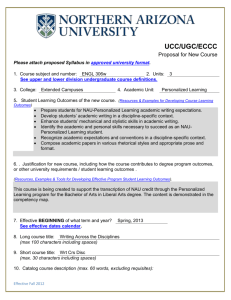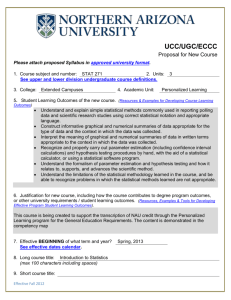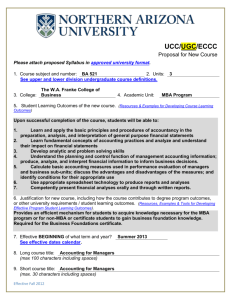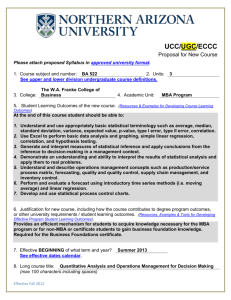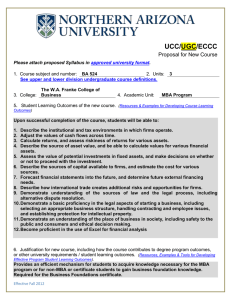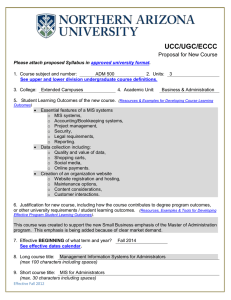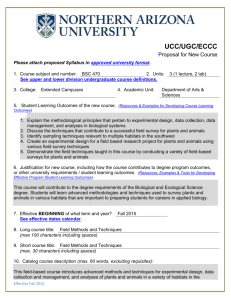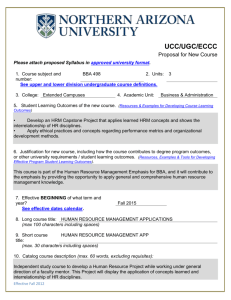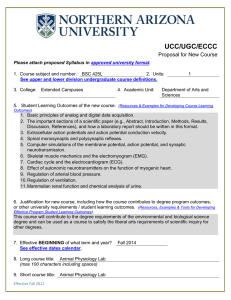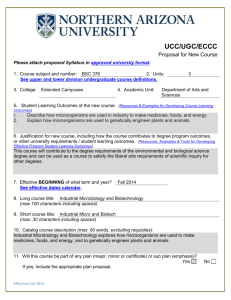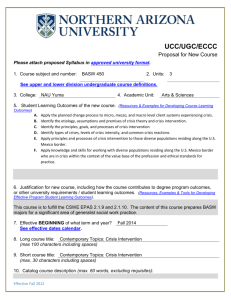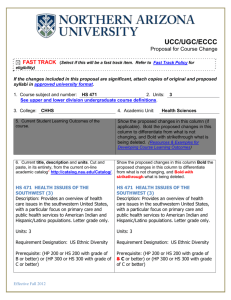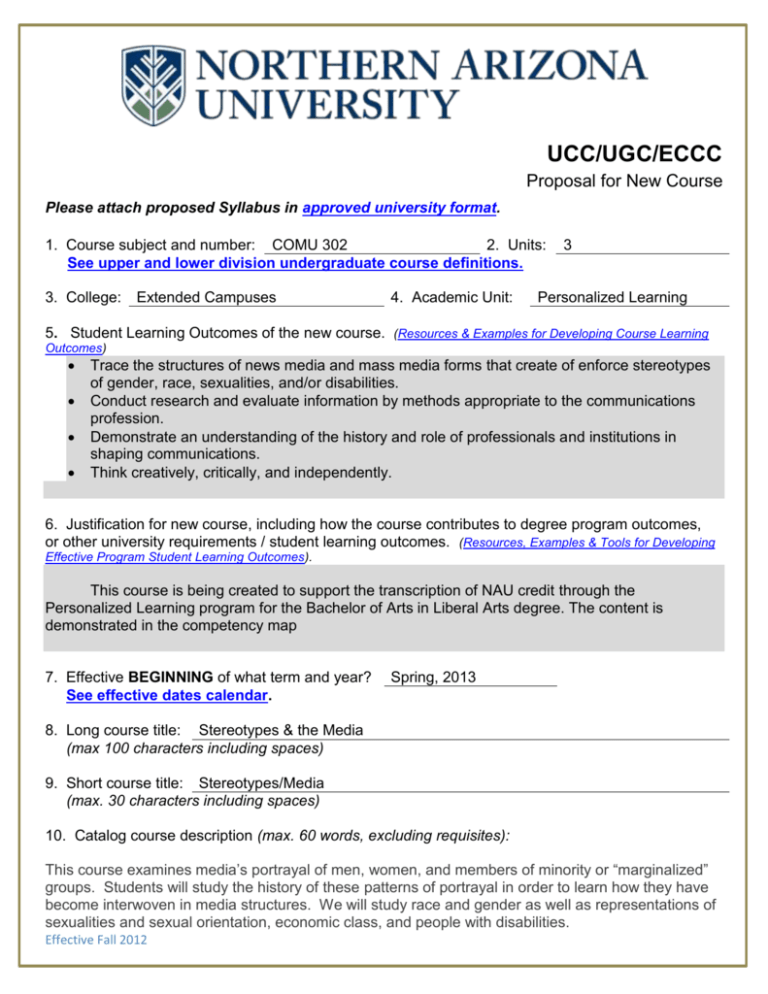
UCC/UGC/ECCC
Proposal for New Course
Please attach proposed Syllabus in approved university format.
1. Course subject and number: COMU 302
2. Units:
See upper and lower division undergraduate course definitions.
3. College:
Extended Campuses
4. Academic Unit:
3
Personalized Learning
5. Student Learning Outcomes of the new course. (Resources & Examples for Developing Course Learning
Outcomes)
Trace the structures of news media and mass media forms that create of enforce stereotypes
of gender, race, sexualities, and/or disabilities.
Conduct research and evaluate information by methods appropriate to the communications
profession.
Demonstrate an understanding of the history and role of professionals and institutions in
shaping communications.
Think creatively, critically, and independently.
6. Justification for new course, including how the course contributes to degree program outcomes,
or other university requirements / student learning outcomes. (Resources, Examples & Tools for Developing
Effective Program Student Learning Outcomes).
This course is being created to support the transcription of NAU credit through the
Personalized Learning program for the Bachelor of Arts in Liberal Arts degree. The content is
demonstrated in the competency map
7. Effective BEGINNING of what term and year?
See effective dates calendar.
Spring, 2013
8. Long course title: Stereotypes & the Media
(max 100 characters including spaces)
9. Short course title: Stereotypes/Media
(max. 30 characters including spaces)
10. Catalog course description (max. 60 words, excluding requisites):
This course examines media’s portrayal of men, women, and members of minority or “marginalized”
groups. Students will study the history of these patterns of portrayal in order to learn how they have
become interwoven in media structures. We will study race and gender as well as representations of
sexualities and sexual orientation, economic class, and people with disabilities.
Effective Fall 2012
11. Will this course be part of any plan (major, minor or certificate) or sub plan (emphasis)?
Yes
If yes, include the appropriate plan proposal.
No
12. Does this course duplicate content of existing courses?
Yes
No
If yes, list the courses with duplicate material. If the duplication is greater than 20%, explain why
NAU should establish this course.
This course does not duplicate content of existing course, but is aligned to the learning outcomes
from COM 301.
13. Will this course impact any other academic unit’s enrollment or plan(s)?
If yes, include a letter of response from each impacted academic unit.
14. Grading option:
Letter grade
Yes
Pass/Fail
No
Both
15. Co-convened with:
n/a
14a. UGC approval date*: n/a
(For example: ESE 450 and ESE 550) See co-convening policy.
*Must be approved by UGC before UCC submission, and both course syllabi must be presented.
16. Cross-listed with:
n/a
(For example: ES 450 and DIS 450) See cross listing policy.
Please submit a single cross-listed syllabus that will be used for all cross-listed courses.
17. May course be repeated for additional units?
16a. If yes, maximum units allowed?
16b. If yes, may course be repeated for additional units in the same term?
Yes
No
Yes
No
18. Prerequisites:
n/a
If prerequisites, include the rationale for the prerequisites.
Pre-requisite content sequencing and verifications are completed through pre- and post- test and in
conjunction with faculty mentors, and are integrated into the curriculum as demonstrated in the
competency maps.
n/a
19. Co requisites:
Effective Fall 2012
If co requisites, include the rationale for the co requisites.
20. Does this course include combined lecture and lab components?
Yes
No
If yes, include the units specific to each component in the course description above.
Cori Gordon, Dora Donovan, and
21. Names of the current faculty qualified to teach this course: Jeannie Copley.
Answer 22-23 for UCC/ECCC only:
22. Is this course being proposed for Liberal Studies designation?
If yes, include a Liberal Studies proposal and syllabus with this proposal.
Yes
23. Is this course being proposed for Diversity designation?
If yes, include a Diversity proposal and syllabus with this proposal.
Yes
Reviewed by Curriculum Process Associate
Date
Approvals:
Department Chair/ Unit Head (if appropriate)
Date
Chair of college curriculum committee
Date
Dean of college
Date
For Committee use only:
UCC/UGC/ECCC Approval
Effective Fall 2012
Date
No
No
Approved as submitted:
Yes
No
Approved as modified:
Yes
No
Effective Fall 2012
SYLLABUS
Stereotypes & the Media
(COMU 302)
I.
Course Description:
This course examines media’s portrayal of men, women, and members of minority or
“marginalized” groups. Students will study the history of these patterns of portrayal in order to learn
how they have become interwoven in media structures. We will study race and gender as well as
representations of sexualities and sexual orientation, economic class, and people with disabilities.
II.
Student Learning Outcomes:
At the successful completion of the lessons associated with this course, students will be
able to:
Trace the structures of news media and mass media forms that create of enforce stereotypes of
gender, race, sexualities, and/or disabilities.
Conduct research and evaluate information by methods appropriate to the communications
profession.
Demonstrate an understanding of the history and role of professionals and institutions in
shaping communications.
Think creatively, critically, and independently.
Effective Fall 2012

